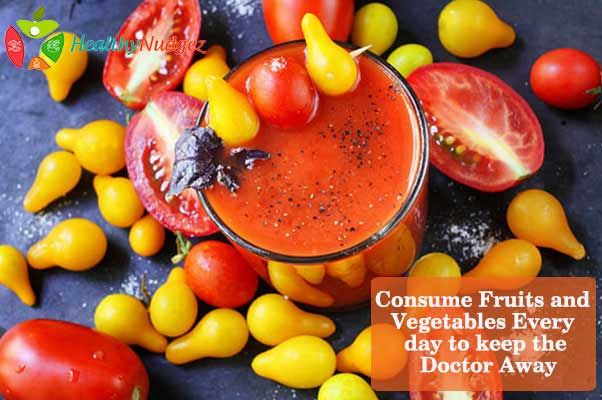5 Fruits and Vegetables Every day to keep the Doctor Away
The World Health Organisation and Food and Agriculture of the United States reports recommend adults to consume at least five servings of fruits and vegetables per day excluding starchy vegetables. The Dietary Guidelines for Americans 2010 recommend you make one-half of your plate should be made up of fruits and vegetables. The Australian Dietary guidelines recommends an intake of about 5-7 servings of fruits and vegetables in our daily diet. ICMR (Indian Council of Medical Research) has also revised the daily recommended allowance for Indians, of fruits and vegetables to minimum of 5 servings per day. This means an average of 500-750 gm of fruits and vegetables have been recommended for normal adults, to be included daily in the diet.
Non-communicable diseases, such as obesity, cardiovascular diseases, diabetes, hypertension, cancers and chronic respiratory diseases, account for about 60% deaths each year worldwide. In addition to causing premature deaths, these diseases cause complications and disabilities, limit productivity, decreases quality of life, require costly treatments with implicit social burden and adverse health financing outcome for individual, family and country.
Fruits and vegetables not only provide a wide range of flavours, colours and textures in the diet, are also an important source of essential nutrients such as vitamin A, vitamin C, potassium and folate, are a major source of fibre, and help to reduce the energy density of the diet.
Observational epidemiologic studies have suggested that dietary nutrients such as potassium, antioxidants, folic acid and fiber—abundant in fruit and vegetables—are associated with a lower incidence of and mortality from non-communicable chronic diseases.
The nutrients of importance found in fruits and vegetables are:
- Energy: Fruits and vegetables are naturally low in glucose and fat. The type of sugar that is found in fruits is fructose which helps to improve satiety and immediate decrease in appetite. All vegetables except, potatoes, have no starch and so provide very little energy. Both the fruits and the vegetables have a very low glycemic load, which means that a large quantity of these are required to raise the blood sugar levels above acceptable levels. Fruits and vegetables both have negligible amounts of fats and have no cholesterol.
- Fiber: Fruits and vegetables especially green leafy vegetables, beans and peas are all very rich in their fiber content. Fiber helps to clean the gut, increase satiety, decrease appetite and therefore helps to keep the body weight in check or rather helps to decrease weight and reduce the risk of many other chronic diseases.
- Antioxidants: Fruits and vegetables are a rich source of antioxidants Vitamins A and C, which help to clean the body of free radicals (toxins) and act as natural scavengers (detox). The anthocyanins, flavonols and procyanidins found in vegetables and fruits have been proven to be effective against cardiovascular diseases and vitamin C in certain fruits helps to reduce blood pressure and also LDL (low density lipoproteins) levels in blood. An increased consumption of cruciferous vegetables was also reported to cause a decrease in the risk of intestinal, bowel, thyroid, pancreatic and lung cancer . Apart from all this the antioxidants in the fruits and vegetables help keep the teeth and the gums healthy and the skin glowing. These help to boost the body’s immune system.
- Potassium: Potassium, found in abundance in all fruits and vegetables, is required to maintain the fluid and electrolyte balance in the body, to avoid dehydration and improve heart health and blood pressure. It helps to keep the body hydrated and works along with sodium to maintain the normal cellular functions.
- Folate: This is another important nutrient found in fruits and vegetables. It is required for the formation of red blood cells and therefore, helps to avoid megaloblastic anaemia. It is very important for the pregnant mothers so as to avoid the neural tube defects in the child.
The relationship between fruits and vegetables consumption and reductions in risk for many major health problems is strongly supported in several research studies. They are believed to be protective against adiposity and are considered as a potential treatment in the management of obesity. It has also been shown in many studies that the frequency of intake of fruits and vegetables is inversely proportional to the risk of chronic diseases.
The greatest challenge, however is to translate knowledge into behavioral action and ensuring every opportunity for communicating and eating seasonal fruits and vegetables using daily checklist.
Contact: Best Nutritionist Near Me


I microwave my spaghetti squash. Poke it all over with a fork, cook 8 minutes. Then turn over and cook 8 more minutes. Viola! Thanks for the recipe, I’m going to try it tonight.
This recipe is AMAZING. I will eat this for the rest of my life! So good and easy-peasy.
I made this recipe tonight. I skipped the chili garlic sauce and added a teaspoon of chili powder instead (as we are spice wimps at my house). It was so good and different. My 3 & 5 year old both liked and ate it as well.
I love how you prep food. It is just one of the things I have learned from you. This is going on next week’s menu. I prefer the reds and orange for stuffing, and for some reason I like the horizontal cut. I think it is because of the proportion of filling to pepper. Anyway, thanks again. I really appreciate you.
I just made these with ground chicken instead of turkey… wonderful.
I made this last night and it is delicious! Just wondering what is considered one serving for the nutritional information? Is that 2 prepared chicken breasts.